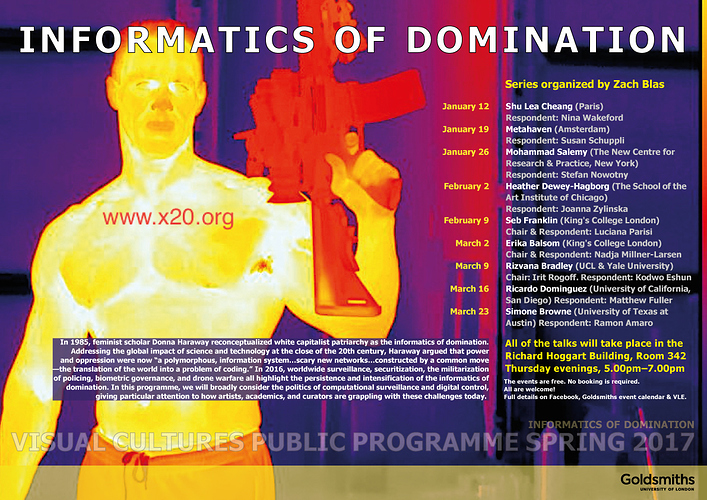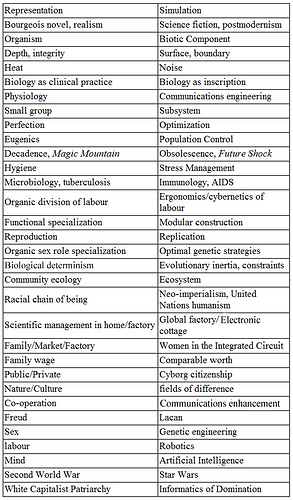Starting this month and continuing through March, the Department of Visual Cultures at Goldsmiths, University of London presents a weekly lecture series entitled “Informatics of Domination,” organized by artist and writer Zach Blas. e-flux conversations will publish selected lectures from the series. Today we present an extended introduction by Zach Blas. The full lecture schedule is on the flyer above.
Text by Zach Blas
A section titled “The Informatics of Domination” sits halfway through Donna Haraway’s 1985 text “A Cyborg Manifesto.” At its start, Haraway gives a name to describe the transformation of power at the close of the twentieth century:
In this attempt at an epistemological and political position, I would like to sketch a picture of possible unity, a picture indebted to socialist and feminist principles of design. The frame for my sketch is set by the extent and importance of rearrangements in world-wide social relations tied to science and technology. I argue for a politics rooted in claims about fundamental changes in the nature of class, race, and gender in an emerging system of world order analogous in its novelty and scope to that created by industrial capitalism; we are living through a movement from an organic, industrial society to a polymorphous, information system—from all work to all play, a deadly game. Simultaneously material and ideological, the dichotomies may be expressed in the following chart of transitions from the comfortable old hierarchical dominations to the scary new networks I have called the informatics of domination.
(161)
In her accompanying table, science fiction reigns, the future of labor is robotic, and white capitalist patriarchy is recast as the informatics of domination. Here, informatics can be defined as information grasped within its social conditions. Haraway’s insistence on framing power through informatics draws attention to the wielding of power in and through networked information machines. That is, if people are increasingly governed informatically, then white capitalist patriarchy is no longer a sufficient concept to elucidate the newer technical materialities through which such power dominates. Notably, Haraway’s articulation of the informationalization of power coincides with another theory, also marked by developments in computer science and digital technologies—namely, Gilles Deleuze’s conception of control societies (1992). Like control, the informatics of domination signals a historical shift from disciplinary societies and panopticism; but might the informatics of domination be the feminist analogue to control? Not only does the informatics of domination, as a theory, emerge within the context of feminist science and technology studies, but it is also a direct reworking of patriarchy.
Haraway further clarifies the mode in which the informatics of domination operate: “communications sciences and modern biologies are constructed by a common move—the translation of the world into a problem of coding” (164). This provokes something of a conundrum for minoritarian struggles, as strategies for political liberation have oriented around gaining representation and enabling the subaltern to speak, as well as a range of textual and visual tactics. When humans are transformed into code and brought into an informatic reign, mustn’t political, critical, and aesthetic responses to power necessarily reconfigure? I am reminded of a text by media theorist N. Katherine Hayles titled “Print is Flat, Code is Deep,” in which Hayles argues that the time-honored and honed skills of literary textual analysis, used to critique print works, fall short when considering a work of electronic literature because “the text” is constructed by software, code, and electronics—not print. Hayles defines her scholarly method as “medium-specific analysis,” and it stipulates that the informatic is distinct from the textual—and by inference, the visual. Thus, the challenge Haraway and Hayles present is to do feminist work by attending to the informatic transformations of power, which are specific and material. Resultantly, a flurry of questions and concerns demands confrontation, such as, how is information created and controlled? Theoretical terms like “mediation,” “capture,” and “protocol” are crucial to start formulating responses. Ultimately, opposing the informatics of domination requires a proliferation of informatic counter-vectors—an informatic feminism, an informatic queerness, an informatic antiracism, an informatic aesthetics.
Strikingly, Haraway invests in myth-making and fiction as a means to combat the informatics of domination. For instance, the cyborg is a feminist myth that has the agency to intervene into the political trajectories of networked information technology; it “is the self feminists must code” (163). Notice that Haraway does not state “write” or “paint.” Coding can also generate a resistant informatics that is grounded in social reality and aesthetics. Indeed, it is Haraway’s feminist framing of power and the arts that motivates the Spring 2017 Public Programme of the Department of Visual Cultures at Goldsmiths. By organizing a lecture series around the informatics of domination, I understand this as bringing together scholars, artists, and curators who are committed to investigating, critiquing, and reimagining the informatic dimensions of power and control today, particularly those engaging such issues from feminist, queer, critical race, and minoritarian positions. This approach necessarily leads to the queer science fiction of cyberfeminist Shu Lea Cheang, and also to the pioneering hacktivist work that Ricardo Dominguez continues to develop around electronic disturbance, Mayan technology, and the Science of the Oppressed. Other invited speakers advance the informatics of domination into the realm of twenty-first century urgencies: Heather Dewey-Hagborg uses bio art to explore futures of genetic surveillance; Mohammad Salemy critiques the “post-internet” and paradigms of artificial intelligence; and Rizvana Bradley thinks blackness’ relations to the internet and the digital. Some guests invest in many of Haraway’s initial concerns, by focusing on design, labor, and vision: Metahaven present films and a lecture that unfold the potentialities of “design research”; Seb Franklin traces the transformations of labor wrought by digitality; and Erika Balsom discusses capture and control in late film/video works by Harun Farocki. Still others detail longer histories of informatics and subjugation, such as Simone Browne, in her work on slavery and surveillance.
In 2017, the informatics of domination has only intensified: drone warfare, biometric governmentality, and mass securitization evidence as much. A key question has also intensified: What are the myths, fictions, and artistic practices that join together with social struggles to deliver an informatics without domination?
×

